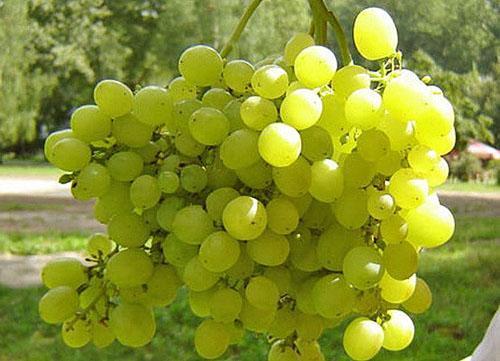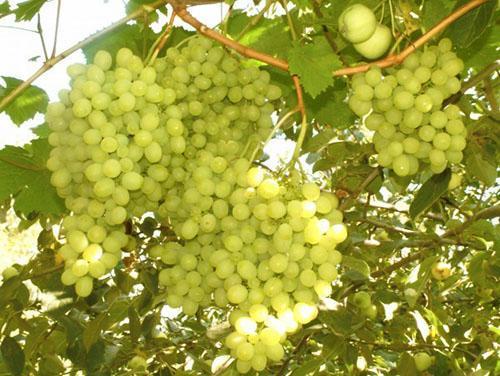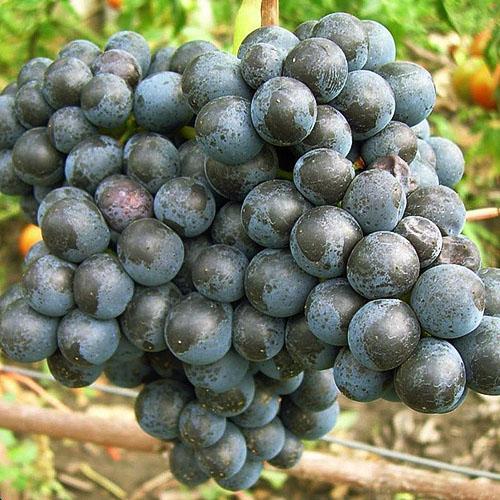Planting and growing grapes in the Urals
 Grapes have always been considered a southern inhabitant, very heat-demanding. In the short Ural and Siberian summers, it was not a promising agricultural crop. However, in recent decades, breeders have developed new varieties that are able to withstand severe frosts without damage. These varieties have become very popular with wine enthusiasts in the Urals and Siberia.
Grapes have always been considered a southern inhabitant, very heat-demanding. In the short Ural and Siberian summers, it was not a promising agricultural crop. However, in recent decades, breeders have developed new varieties that are able to withstand severe frosts without damage. These varieties have become very popular with wine enthusiasts in the Urals and Siberia.
The Urals are located in two climatic zones: temperate and subarctic. Winter temperatures in the region range from -16 ˚C in the Southern Urals to -24 ˚C in the Subpolar region. Summers are short here, they can be dry and hot, but they can be rainy and cold. Due to such instability of the climate, the Ural belongs to the zone of risky agriculture. However, if agrotechnical rules are observed, good yields of sun berries can be obtained here too. Read the article:preparing grapes for winter.
Selection of grape varieties for cultivation in the Urals

 By the ripening period for the Urals, one must choose early grape varieties (90-110 days) and medium early (115-130 days).
By the ripening period for the Urals, one must choose early grape varieties (90-110 days) and medium early (115-130 days).
The following varieties have established themselves as the best in the Ural climatic conditions:
- In memory of Dombrovskaya - early (90-100 days). Bunches up to 400 g, black berries, pitted.
- In memory of Shatilov - early (100 days), very winter hardy. The berries are light.
- Early pink nutmeg - 110 days, pink berries, fragrant. A bunch of up to 700 g.
- Samokhvalovich - early (110 days). A bunch of up to 200 g, dense. The berries are fragrant, pinkish-green.
- Olga or Krasa Severa - early (110 days). A bunch of up to 600 g, amber-yellow berries.
- Aleshenkin or Alyosha - medium early (115 days). A bunch of up to 700 g, berries are light, amber.
- Negro baby - medium early (125 days). A bunch of up to 600 g, brown berries, tasty.
- Lydia - medium early (125 days). A bunch of up to 200 g, yellow-pink berries, fragrant.
- Shatilova white muscat - medium early (130 days). Bunches grow up to 1 kg, berries are light yellow, fragrant. A very productive variety.
Experienced winegrowers in the Ural region are advised to start with the varieties "Memory of Shatilov", "Memory of Dombrovskaya", "Aleshenkin". These varieties are the most unpretentious, easy to care for and winter hardy.
Planting and growing
 Planting seedlings is best done in the second half of June-July, when the threat of frost has passed and the soil warms up to +15 ˚С. For planting, you need to choose the sunniest place on the site, from where the sun does not leave all day. At the grape planting site, the soil must be loose, nutritious, moisture and air permeable.
Planting seedlings is best done in the second half of June-July, when the threat of frost has passed and the soil warms up to +15 ˚С. For planting, you need to choose the sunniest place on the site, from where the sun does not leave all day. At the grape planting site, the soil must be loose, nutritious, moisture and air permeable.
For each bush, a feeding area of at least 1 m is provided2. Single bushes can be planted in holes 1 X 1 X 1 m in size. If you plan to plant bushes in a row, you need to prepare a trench 1 m wide and 1 m deep.Its length is calculated by the number of bushes: at least 1 m for each plant. The best location for the trench is north to south. At the bottom of the pit or trench, it is necessary to arrange drainage: lay 20-30 cm of large stones, cobblestones. Pour a layer of 10-15 cm of expanded clay or fine gravel on them. Fill the rest of the hole with a mixture of sand (or vermiculite), mature humus and garden soil. You can add phosphoric and potash fertilizers, wood ash.
The planting hole is prepared 2 months before planting the seedlings, around March-April. The pit needs to be watered several times so that the soil in it settles and compresses. The soil should not reach the edges by 20 cm. Next year, the pit will need to be filled with soil to the top and at the same time the grapes should be piled up to a height of 30 cm. The bushes growing in the trench should be piled up in the manner of potatoes - with a comb. This technique will allow you to accumulate heat in the soil around the bushes.
 For a seedling, a small hole is dug in the middle of the prepared hole, watered with water, and grapes are planted. The soil around the seedling is compacted. Water as the soil dries up, but not very abundantly. When the seedling starts to grow, watering is stopped - the grapes will have enough water that is in the soil. In total, 2-3 abundant watering needs to be done over the summer.
For a seedling, a small hole is dug in the middle of the prepared hole, watered with water, and grapes are planted. The soil around the seedling is compacted. Water as the soil dries up, but not very abundantly. When the seedling starts to grow, watering is stopped - the grapes will have enough water that is in the soil. In total, 2-3 abundant watering needs to be done over the summer.
Stationary greenhouses should not be used for planting grapes, since the plant requires a snow shelter for successful wintering.
 In the first, and sometimes in the second, grape seedlings are not pruned. They must gain root mass and grow 1-2 vines at least one meter long. To do this, the strongest shoots are chosen from the seedling, and the rest are broken out as they appear. It is possible to leave one additional shoot until autumn - a reserve one. In the fall, the weakest vine is removed.
In the first, and sometimes in the second, grape seedlings are not pruned. They must gain root mass and grow 1-2 vines at least one meter long. To do this, the strongest shoots are chosen from the seedling, and the rest are broken out as they appear. It is possible to leave one additional shoot until autumn - a reserve one. In the fall, the weakest vine is removed.
If only one shoot was left on the handle, then a strong stepson should be left on it closer to the base and pinched along with the main vine. Next year, this stepson will catch up with the vine in growth. One male shoot should always be left on the plant - for pollination.
 Processing grapes in summer includes watering, pinching, chasing (pinching the tops of the vines), mulching the soil. Watering it is necessary to produce at the root with plenty of water so that the soil is well saturated. Do not water the grapes over the foliage, especially in hot weather. It is very good to sow green manures near the bushes, the overgrown cut grass can be left right there to mulch the soil - this is very fond of grapes. In July, work in the vineyard should be aimed at protecting plants from fungal diseases. At the beginning of the month, fertilizing with complex fertilizer should be done.
Processing grapes in summer includes watering, pinching, chasing (pinching the tops of the vines), mulching the soil. Watering it is necessary to produce at the root with plenty of water so that the soil is well saturated. Do not water the grapes over the foliage, especially in hot weather. It is very good to sow green manures near the bushes, the overgrown cut grass can be left right there to mulch the soil - this is very fond of grapes. In July, work in the vineyard should be aimed at protecting plants from fungal diseases. At the beginning of the month, fertilizing with complex fertilizer should be done.
 The grapes always form many more buds and fruit clusters than they can "feed". If all of them are allowed to ripen, the bush will quickly weaken and the berries on it will become small. And during the short Ural summer they simply will not mature on time. Therefore, some of the brushes must be removed from the grapes. Usually 3-4 ovaries are left per vine. If two brushes have grown side by side - remove the smaller and weaker one. Alternatively, you can allow all the brushes to pollinate and tie, and only then remove the weak and rare clusters.
The grapes always form many more buds and fruit clusters than they can "feed". If all of them are allowed to ripen, the bush will quickly weaken and the berries on it will become small. And during the short Ural summer they simply will not mature on time. Therefore, some of the brushes must be removed from the grapes. Usually 3-4 ovaries are left per vine. If two brushes have grown side by side - remove the smaller and weaker one. Alternatively, you can allow all the brushes to pollinate and tie, and only then remove the weak and rare clusters.
During the ripening of berries, they must be carefully examined and damaged and sick ones removed. In September, leaves should be gradually removed from the fruit vine in order to expose the berries to the sun. Do not pick off all the leaves at once - this can lead to sunburn of the bunch and vines.
As the vines grow and the berries ripen, the grapes are strengthened on a support. It can be a pole with crossbars, a trellis, a gazebo.
Pruning grapes
 Pruning vines is essential to increase yields as well as to better prepare for winter. Pruning is done throughout the season (breaking out stepchildren) and in the fall. Autumn pruning is done after harvest, with the onset of the first frost.
Pruning vines is essential to increase yields as well as to better prepare for winter. Pruning is done throughout the season (breaking out stepchildren) and in the fall. Autumn pruning is done after harvest, with the onset of the first frost.
Many aspiring growers ask the question: how to prune grapes in summer? Summer pruning includes:
- Pruning the ends of the vines that have dried up over the winter.
- Removal of weak and rare ovaries.
- Regular removal of stepchildren and weak shoots.
- Minting (pinching) from mid-July to late August.
- Clarification of the crown in September - removal of part of the leaves. Leaves shading ripening brushes, lower leaves, as well as old and diseased leaves are removed.
With the help of autumn pruning, fruit vines (sleeves) and replacement shoots are formed. For the Ural region, the most optimal is a standard fan cut for four sleeves. On the trunk, four vines are formed with a fruit zone and replacement shoots (knots) at the base.
For the first time, the vines and the abandoned stepson (if any) are cut to a length of 4-6 buds, removing all stepsons, antennae, leaves. Then the vines are pinned horizontally above the ground for shelter for the winter.
In the second year, new shoots will develop from the buds left. Of these, the 4 strongest are left (2 on each vine), and the rest are removed. By the fall, young vines will develop from these shoots, which next year will already be able to please with the first harvest.
The most productive part of the fruit vine is in its middle. This should be remembered when doing an autumn short pruning, and leave 8-10 buds on them. In the spring, a strong shoot must be left at the base of each such vine, which will develop over the summer and become a replacement shoot for the fertile vine. After 3-4 years of fruiting, the vines are cut out in the fall, leaving a small stump, and replaced by the young ones left behind. Thus, 3-4-year-old grape vines can grow on developed roots, numbering for two to three decades.
You can see the procedure for pruning grapes in the fall in the video:
Shelter grapes for the winter
 Shelter grapes for the winter is a responsible business. The safety of the bushes and the harvest for the next year depend on the quality of the shelter. It is impossible to cover the grapes too wound, because during warming, mold can form on the buds and destroy them. It is necessary to cover the grapes when the air temperature drops to -5 ˚С and the top layer of the soil freezes. In the southern Urals, this is usually mid-November. The buds of grapes, especially of zoned varieties, are able to withstand frost down to -20 ˚С, and therefore will calmly survive until this period.
Shelter grapes for the winter is a responsible business. The safety of the bushes and the harvest for the next year depend on the quality of the shelter. It is impossible to cover the grapes too wound, because during warming, mold can form on the buds and destroy them. It is necessary to cover the grapes when the air temperature drops to -5 ˚С and the top layer of the soil freezes. In the southern Urals, this is usually mid-November. The buds of grapes, especially of zoned varieties, are able to withstand frost down to -20 ˚С, and therefore will calmly survive until this period.
The vines should not be laid directly on the ground, otherwise they may get wet in the spring when the soil thaws. It is best to place them on a wooden trellis or on a layer of dry pine needles. From above, they must be covered with pine or spruce spruce branches, non-woven material in several layers, tarpaulin. If the bushes are small, you can use the following shelter method: roll the vines into a ring, lay them on a layer of dry needles and cover them with a wooden box or bucket. Top the box with spruce branches or a thick layer of straw.
 The topmost covering layer is a film, roofing felt or slate. After that, it remains to wait for the snow. The Ural winter can bring snow both in abundance and in shortage. In any case, by the time of severe frosts, the thickness of the snow cover on the grape shelter should be at least 40 cm. Such a level of snow will allow maintaining a constant temperature in the shelter throughout the winter. If there is little snow, then it is better to specially heat it on the vineyard.
The topmost covering layer is a film, roofing felt or slate. After that, it remains to wait for the snow. The Ural winter can bring snow both in abundance and in shortage. In any case, by the time of severe frosts, the thickness of the snow cover on the grape shelter should be at least 40 cm. Such a level of snow will allow maintaining a constant temperature in the shelter throughout the winter. If there is little snow, then it is better to specially heat it on the vineyard.
In the spring, immediately after the snow has melted, the shelter must be opened to provide fresh air to the vines. Before the start of sap flow, grape buds are not afraid of frost, but they should be covered with non-woven material or spruce branches from sunburn.
With the beginning of sap flow, the grapes must be covered again, especially at night. Vines overflowing with sap can die if frost turns them into ice. The shelter should be completely removed only after the end of the return frosts. By this time, new shoots on the vines have time to grow 15-20 cm. When the vines are strengthened on the trellises, part of the young shoots can be broken off. Therefore, during the autumn short pruning, it is necessary to leave 2-3 more buds - for insurance.
Despite the harsh winters and short summers, the Urals today are quite a suitable place for growing grapes. Through the efforts of lovers of sunny berries in the region, it is possible to obtain fairly high yields.